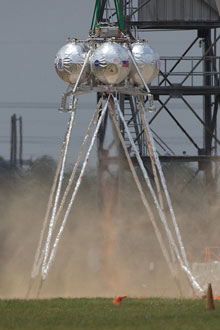See NASA’s New Lunar Lander in Flight
Project Morpheus is making subtle, but noisy, progress at NASA. The experimental spacecraft is designed to carry cargo to the moon, an asteroid, or Mars, but the model shown here will never actually land on such surfaces. It is being used to test new technologies, such as propulsion, guidance, navigation, and control systems, and optical sensors that would allow for a safe descent and landing.

Morpheus recently conducted its first tethered flights at Johnson Space Center (JSC) in Houston (see the video below) and will be taking its first untethered flight this month, making it the first prototype spacecraft to fly at JSC since before man walked on the moon.
Morpheus is also testing a new, greener propellant, liquid oxygen and methane. The mixture is cheaper, lighter, and safer than than traditional spacecraft fuels. It can also be stored for longer periods of time in space, and the methane could perhaps even be made from ice on the moon or Mars.
The vehicle is also focused on testing safer landing technologies, specifically a system developed by NASA to detect hazards like craters or slopes in real-time. The system, called the Autonomous Landing and Hazard Avoidance Technology, uses beams of light and optical sensors to profile a landing surface.
But the project, designed and developed in less than a year, is more than a technology demonstration, it’ also a cultural shift for NASA. It’s a hands-on testing approach: get the technology developed quickly and efficiently and use failures to drive improvement. “Projects like Morpheus are invigorating and infectious,” said Steve Altemus, director of Johnson’s Engineering Directorate, in the NASA press release. “And they help us find better and cheaper ways to do things. To challenge our existing processes. To innovate.”
At a time when NASA’s future is filled with lots of questions and uncertainties, innovations with a clear purpose are exactly what the agency needs.

Keep Reading
Most Popular
Large language models can do jaw-dropping things. But nobody knows exactly why.
And that's a problem. Figuring it out is one of the biggest scientific puzzles of our time and a crucial step towards controlling more powerful future models.
How scientists traced a mysterious covid case back to six toilets
When wastewater surveillance turns into a hunt for a single infected individual, the ethics get tricky.
The problem with plug-in hybrids? Their drivers.
Plug-in hybrids are often sold as a transition to EVs, but new data from Europe shows we’re still underestimating the emissions they produce.
Stay connected
Get the latest updates from
MIT Technology Review
Discover special offers, top stories, upcoming events, and more.